Beaucaire, Gard
| Beaucaire | ||
|---|---|---|
| Commune | ||
|
View over Beaucaire | ||
| ||
 Beaucaire | ||
|
Location within Occitanie region  Beaucaire | ||
| Coordinates: 43°48′29″N 4°38′39″E / 43.8081°N 4.6442°ECoordinates: 43°48′29″N 4°38′39″E / 43.8081°N 4.6442°E | ||
| Country | France | |
| Region | Occitanie | |
| Department | Gard | |
| Arrondissement | Nîmes | |
| Canton | Beaucaire | |
| Intercommunality | Community of communes Beaucaire-Terre d'Argence | |
| Government | ||
| • Mayor (2014–2020) | Julien Sanchez (FN) | |
| Area1 | 86.52 km2 (33.41 sq mi) | |
| Population (2012)2 | 15,860 | |
| • Density | 180/km2 (470/sq mi) | |
| Time zone | CET (UTC+1) | |
| • Summer (DST) | CEST (UTC+2) | |
| INSEE/Postal code | 30032 /30300 | |
| Elevation |
1–156 m (3.3–511.8 ft) (avg. 18 m or 59 ft) | |
|
1 French Land Register data, which excludes lakes, ponds, glaciers > 1 km² (0.386 sq mi or 247 acres) and river estuaries. 2 Population without double counting: residents of multiple communes (e.g., students and military personnel) only counted once. | ||
Beaucaire (French pronunciation: [bokɛʁ]; Occitan: Bèucaire [bɛwˈkajɾe]) is a French commune in the Gard department in the Occitanie region of southern France.[1]
The inhabitants of the commune are known as Beaucairois or Beaucairoises.[2]
The commune has been awarded one flower by the National Council of Towns and Villages in Bloom in the Competition of cities and villages in Bloom.[3]
Geography

Beaucaire is located on the Rhône River some 15 km south-west of Avignon and 10 km north of Arles opposite Tarascon, which is in Bouches-du-Rhône department of Provence. Access to the commune is by the D999 road from Jonquières-Saint-Vincent in the west which passes through the north of the commune and the town and continues east to Tarascon. The D966L comes from Saint-Bonnet-du-Gard in the north and comes down the banks of the Rhône to the town. The D90 branches off the D986L in the commune and passes in a circle around the town then continues east across the Rhone changing to the D99B. The D15 goes south from the town to Fourques. The D38 goes south-west from the town to Bellegarde. The D28 links the Ile du Comte to the east bank of the Rhone. A railway passes through the commune coming from Tarascon in the east with two stations in the commune then it continues to Nîmes in the west. Apart from the main town there are also the districts of Gaudon, Tour Saint-Pierre, Pauvre Menage, Malatrache, Mas du Consul, Mas Saint-Andre du Boschet, Mas de la Bastide, Mas des Lecques, Le Fer a Cheval, Saujean, Mas de SAicard, Bieudon, and Enclos d'Argent. The commune has a large urban area in the north-east with the rest of the commune farmland.[4][5]
The Rhône river forms the whole eastern border of the commune as it flows south to join the sea at Port-Saint-Louis-du-Rhône. The river is also the departmental border between Gard and Bouches-du-Rhône. The Canal du Rhône à Sète passes through the commune from Saint-Gilles in the south-west and joins the Rhone in the town. A waterway called Laune de Pillet, a branch of the Rhone, cuts through the commune parallel to the Rhone forming the Ile de Pillet. There is an extensive network of irrigation canals covering most of the farmland.[4][5]
Relief
The entire town is located in the Rhône Valley and has fairly flat terrain mainly formed by the plain of the Rhône. The north of the commune has hills, especially north of the town centre where the castle is located (80 metres high) as well as Saint-Roman (130 metres).
| Neighbouring communes and villages[4] | ||||
|---|---|---|---|---|
 |
Jonquières-Saint-Vincent | Comps | Vallabrègues |  |
| Manduel | |
Tarascon | ||
| ||||
| | ||||
| Bellegarde | Fourques | Fontvieille | ||
Toponymy
'Beaucaire' probably is the French version of the Occitan language name 'Bèucaire':
- Beau < French beau ('Beautiful') < Occitan bèl/bèu ('Beautiful')
- Caire < Occitan caire ('Cut stone or rock') [in French pierre de taille].[6]
Beaucaire appears as Beaucaire on the 1750 Cassini Map[7] and the same on the 1790 version.[8]
History
Ancient times
Founded in the 7th century BC, Beaucaire was known as a city on the famous Via Domitia, the first Roman road built in Gaul linking Italy to Spain (121 BC.). It was at this point that the Via Domitia divides in the direction of Arles, Nîmes, Remoulins, and Saint-Gilles. At that time, Beaucaire was called Ugernum. This was where, after the capture of Rome by the Vandals in 455, the Gallo-Roman nobility met to elect Avitus as the new emperor.[9] A Roman mausoleum has been discovered on the Île du Comté.[10]
Middle Ages
_vue_c%C3%B4t%C3%A9_Nord.jpg)
The Middle Ages saw a slowdown in the expansion of the city. Beaucaire did not escape the troubles during this dark period. It underwent invasions of Burgundians, Visigoths, and Saracens. It was at that time that the first ramparts were built and the castle was expanded. The city took the name Beaucaire (which means "beautiful stone", probably in reference to its many buildings, to its quarries, or the fact that it had the first hills on the Rhone coming from the sea).
During the Albigensian Crusade, Raymond VI of Toulouse besieged Beaucaire in May 1216. The efforts of Simon de Montfort to relieve the town were repulsed. The city fell after a three-month siege.
In the 13th century Louis IX made several trips to Beaucaire. The city was expanding and its population increasing. Despite the Hundred Years War and the Wars of Religion (14th to the 16th century), the splendour and refinement of the architecture grew along with the wealth of the Beaucairois merchants.
In 1579 Beaucaire was held by Henri I de Montmorency, the catholic governor of Languedoc, but tolerant. The captain of the city was Jean de Parabere who was soon to play his own game. Damville then provoked a riot to recover the city but even though Parabere was decapitated, the city remained in the hands of the Huguenots, thanks to reinforcements sent by François de Coligny, the son of Gaspard II de Coligny.[11]
Modern era
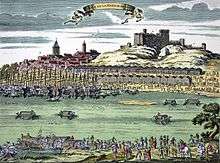
At the end of the Hundred Years War in 1453, Charles VII of France declared that Beaucaire would become the site of the Fair of la Madeleine, a commercial fair that would enable the trade of goods from all of the Mediterranean Basin countries to all of France. By the mid-seventeenth century, the Fair was the largest commercial fair in the Mediterranean region, allegedly exceeding in a week the total volume of trade done in Marseilles in a year. It remained the dominant Mediterranean trade fair until the arrival of the railway in the mid-nineteenth century.[12] The advent of the railway and the end of river trade as well as the removal of its tax-free status by Napoleon gradually destroyed the Fair of the Madeleine and plunged Beaucaire into anonymity. One result of these years of commercial dominance was the construction of a remarkable number of architecturally significant mansions and palaces by rich merchants of many nationalities. The fair still exists in the form of carnivals, bullfights, and various festivities. Camargue bulls are run through the streets. It always starts on 21 July and always ends on a Monday and lasts at least six days.
French Revolution and Empire
Beaucaire was capital of the district from 1790 to 1795. During the French Revolution the commune was temporarily called Pont-National.[13]
Contemporary period
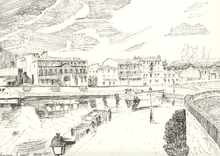
At the end of the 19th century and the early 20th century some works of great value are built such as the banquette - a stone retaining wall along the eastern side of the city which protected it from the flooding of the Rhône, food markets, and the Municipal Casino which is now the Festival Hall. It was also at this time that the Canal du Rhône à Sète was widened. It connects Beaucaire to the Canal du Midi.
In 1940 Beaucaire had a large population of Belgian refugees, mostly from Farciennes. They became twin communes in 1969.[14]
Heraldry
.svg.png) |
Blazon: Party per saltire, Or and Gules. |
Town planning
Beaucaire is one of 79 member communes of the Territorial Coherence Scheme (SCOT) of South Gard and is also one of the 41 communes of Pays Garrigues Costières.
Housing
The town of Beaucaire had 7,054 housing units in 2009, nearly 90% of which were primary residences. There are almost equal amounts of detached houses (52%) and apartments (48%) with the majority of homes having 3 or 4 rooms. Only 47% of residents own their own housing. Of the rental housing (3050 units in 2009) one third are HLM.[15]
Administration
.jpg)
| From | To | Name | Party | Position |
|---|---|---|---|---|
| 1742 | 1759 | Antoine Nazon | ||
| 1959 | 1983 | José Boyer | PCF | General Councilor of the Canton of Beaucaire (1976-1982) |
| 1983 | 2002 | Jean-Marie André | DL | MP for Gard's 2nd constituency (1993-1997) |
| 2002 | 2008 | Mireille Cellier | UMP | Regional Councilor for Languedoc-Roussillon (1998-2010) |
| 2008 | 2014 | Jacques Bourbousson | UDI | President of the CC Beaucaire-Terre d'Argence (2008-2014) |
| 2014 | 2020 | Julien Sanchez | FN | Regional Councilor for Languedoc-Roussillon then Occitanie (since 2010) |
(Not all data is known)
The Municipal Council is composed of 23 members including the Mayor and 9 deputies.[17]
Twinning
Beaucaire has twinning associations with:[18]
.svg.png) Farciennes (Belgium) since 1969.
Farciennes (Belgium) since 1969. Montelupo Fiorentino (Italy).
Montelupo Fiorentino (Italy).
Demography
In 2012 the commune had 15,860 inhabitants. The evolution of the number of inhabitants is known from the population censuses conducted in the commune since 1793. From the 21st century, a census of communes with fewer than 10,000 inhabitants is held every five years, unlike larger communes that have a sample survey every year.[Note 1]
| 1793 | 1800 | 1806 | 1821 | 1831 | 1836 | 1841 | 1846 | 1851 |
|---|---|---|---|---|---|---|---|---|
| 8,510 | 7,943 | 8,671 | 9,825 | 9,967 | 9,601 | 9,795 | 9,725 | 11,045 |
| 1856 | 1861 | 1866 | 1872 | 1876 | 1881 | 1886 | 1891 | 1896 |
|---|---|---|---|---|---|---|---|---|
| 12,713 | 9,544 | 9,395 | 8,804 | 8,777 | 9,724 | 9,824 | 8,947 | 9,020 |
| 1901 | 1906 | 1911 | 1921 | 1926 | 1931 | 1936 | 1946 | 1954 |
|---|---|---|---|---|---|---|---|---|
| 9,143 | 8,764 | 8,488 | 7,916 | 8,479 | 9,701 | 10,059 | 9,343 | 10,197 |
| 1962 | 1968 | 1975 | 1982 | 1990 | 1999 | 2007 | 2012 | - |
|---|---|---|---|---|---|---|---|---|
| 11,061 | 12,740 | 12,829 | 12,840 | 13,400 | 13,748 | 15,274 | 15,860 | - |
Sources : Ldh/EHESS/Cassini until 1962, INSEE database from 1968 (population without double counting and municipal population from 2006)
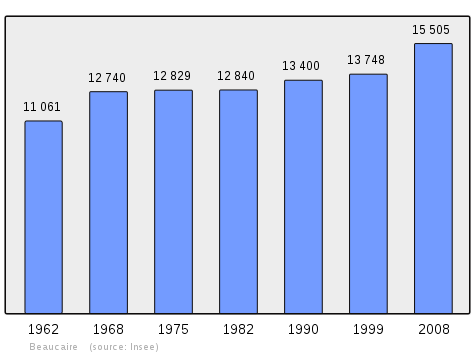
Education
The commune has:[19]
- 4 kindergartens
- 5 Elementary schools
- 2 primary schools
- 3 colleges
- 2 professional schools
Health
Since 30 January 2014 Beaucaire has a multi-activity healthcare division with multi care professionals, a dental centre, opticians, and a hearing specialist.[20]
Cultural events and festivities
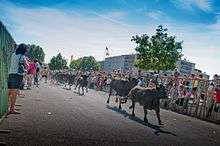
- The Salon des Métiers d'Art is held every year in October. Many craftsmen are selected and come to exhibit their original works. Since 2015, this event has taken place in the conservation area of ??Beaucaire on the Place Georges Clemenceau and also in the inner courtyard of the Town Hall and its Conservatory.
- The Mediterranean Equestrian Meeting is held every year on the first weekend in July. Hundreds of horses from all over Europe meet in Beaucaire. This event diversified in 2015 with a children's area to introduce children and attract families. This huge demonstration, whose total cost is around 100,000 euros, has not been subsidized by the regional council since 2015. Despite the decline in endowment, the commune still maintains it and gives it more scope.
- The City of books since 2007. It hosts publishers, booksellers and organizes a festival of storytelling.
- The Summer Festivals have events such as bullfighting and cultural shows. The city is a member of the Union of French bullfighting cities.
- Le Drac from 20–22 June each year. A celebration of the myth of Le Drac. The townsfolk bring the monster to life in the form of a long procession which snakes through the town led by a swarm of children carrying lanterns.
Worship
The Catholic parish of Beaucaire is part of on the diocese of Nîmes, deanery Plaine gardoise.[21] Protestants also have a church in the commune.[22] There is a Mosque for Moslems.[23]
Economy
Population and income tax
In 2012 the workforce was 6,719 people, including 1,407 unemployed (14.1%. These people are mostly employees (83.7%) and all work inside the commune (100%).[15] On 1 January 2014 there were a total of 1,533 business enterprises in the commune: 155 in Agriculture, 137 in Industry, 232 in construction, 851 in Trade, transport, and services, 289 in automobile trade and repair, and 158 in Administration, education, health, or social services. Out of this 458 businesses employed staff across all sectors.[24]
Notable businesses in the commune
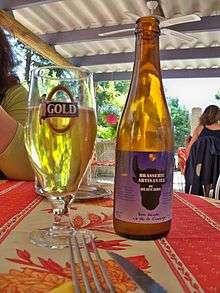
Among local businesses, the Craft Brewery of Beaucaire produces and markets several varieties of beer regionally with some Camargue rice.[25] There are also: a Ciments français cement plant (subsidiary of the Italcementi group),[26] and a Casanis plant from the Bacardi group which markets Get 27.[27] The headquarters of the multinational group Marie Brizard Wine & Spirits (formerly Belvédère) has been located in Beaucaire since 2011.[28]
Culture and heritage
A very large number of buildings and sites are registered as historical monuments. For a complete list including links to descriptions (in French) and some photos click here. Some of the most well known are shown below.
Civil heritage
- Chateau of Beaucaire and its triangular Keep.
- Many Mansions and facades from the 17th and 18th century.
- The Taureau Cocardier (Cocardier bull) Goya, a sculpture by Camille Soccorsi (1984) in the Place Jean-Jaurès.
- The Paul Laurent bullring where are held bullfight events, and shows and concerts during the feria of Sainte-Madeleine.
- The Sculpture of Drac in the Place de la Republique.
- The Vieux Mas, a farmhouse from 1900.
- On the plateau north-west of the town, near the cemetery, lie milestones from the ancient Via Domitia. Consisting of a single stone, they are positioned to the right of the way in the direction Beaucaire-Narbonne. There are many due to the addition of a new milestone in the name of the emperor reigning at each significant repair. These multiple milestones are called Columns of Caesar.[29]
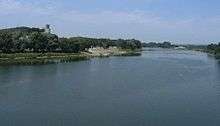 The Rhône and the Château of Beaucaire.
The Rhône and the Château of Beaucaire. The Château de Beaucaire.
The Château de Beaucaire.- The triangular Keep of the Chateau of Beaucaire
 The Hotel of Margallier.
The Hotel of Margallier. Columns of Caesar.
Columns of Caesar. The Bullring
The Bullring Beaucaire Casino
Beaucaire Casino
Religious heritage
Main article: Abbey of Saint-Roman,
- The Troglodytic Abbey of Saint-Roman: atop a limestone outcrop overlooking the Rhone valley at the confluence of the Gardon. This amazing cave monastery, which depended on Psalmody Abbey was abandoned in the 16th century. A fortress was later built partly with stones from the abbey. It was dismantled in 1850 and only a few vestiges of the fortifications are still visible.[30]
- The Collegiate Church of Notre-Dame-des-Pommiers dating from the 18th century, the largest church in the city, baroque.
- The Church of Saint Paul, built in the Provençal Gothic style.
- A Covered Cross.
- An Oratory in memory of Saint Bonaventure and the Virgin; Second Empire period; near Place Jean-Jaurès and the road to Nîmes.
 The Abbey of Saint-Roman
The Abbey of Saint-Roman- The Collegiate church of Notre-Dame
 The Church of Saint Paul interior
The Church of Saint Paul interior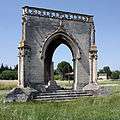 Oratory of the Covered Cross
Oratory of the Covered Cross
Museums
- The Auguste-Jacquet Museum: a museum of history, archeology and traditions of Beaucaire. Located in the former convent of the Augustinian sisters at the foot of the medieval castle.
- The Horse and Equestrian Art Museum, Hall of the Four Kings, Rue du 4 September.
Literature
Poets, living in or passing through Beaucaire, remembered it through their lyrical writing: Joseph D'Arbaud, Marie-Antoinette Rivière (Antoinette of Beaucaire), Juliette Borely, Artalette of Beaucaire.[31]
Legend
Beaucaire has a legend of the formidable drac, a monster that rises from the depths of the sea to seize and devour its prey. One day the monster grabbed a young laundress and brought her to his cave. The story says the woman expected the worst, but the drac explained that what he wanted was a nanny for his son, the draconnet. Thus the washerwoman fed the little monster for seven years before she was set free. But one day at the fair the drac came to the market, having taken on a human appearance. The washerwoman recognized her former captor and incited the crowd to riot. Furious at being unmasked, the drac blinded the washerwoman. According to Gervase of Tilbury who wrote this tale in 1214, she remained blinded until the end of her days.
Notable people linked to the commune
- Raymond VII, Count of Toulouse (1197-1249) retrurned Beaucaire, his birthplace, to the lords of Nord in 1216;
- Jacques Cœur (around 1395/1400-1456), took refuge in 1455;
- François de Rovérié de Cabrières (1830-1921), Bishop of Montpellier then cardinal ;
- Jack Thieuloy (1931-1996), French writer of L'Opéra de Beaucaire ;
- Napoleon Bonaparte, author of Souper de Beaucaire ;
- Jean-Pierre Blaud (1773-1859), inventor of Blaud pills ;
- César Blaud, (died at 77 years old), researcher and author of Antiquité de la ville de Beaucaire, 1819;
- Madeleine Blaud (1887-1942), graduate of the Montpellier school of pharmacy, author of The high schools of tomorrow, 1918;
- Alexandre Pleindoux, doctor, author of medical books and a militant republican;
- Noël Vandernotte (1923-), retired author, youngest athlete in the history of the modern Olympic Games ad vitam æternam (Medal in 1936 as a rowing coxswain);
- Sauveur Betelli, called Toto, bullfighter, resistance fighter;[32]
- Jacques Lardie (1947-), publisher, political journalist, polémicist cartoonist, illustrator, diploma of fine arts, he signed his articles and cartoons with various nicknames with the most common Jihel. Creator of an important historical series called Ciment de l'histoire;
- Michel Odasso (1947-2010), professional footballer from Nîmes Olympique and AS Monaco FC;
- Myriam Stocco (1951-), Miss France 1971, 5th princess of Miss Universe 1971, finalist in Miss World 1971, 3rd proncess in Miss Europe 1971;
- Élizabeth Blaud-Costes (1962-), author of Épopée du costume provençal, de l'orient à la foire de Beaucaire, de l'Antiquité à nos jours, 2012;
- Ludovic Zerti (1968-), bullfighter;
- Johnny Ecker (1973-), professional footballer professionnel for Nîmes Olympique, Lille OSC, Olympique de Marseille, EAG;
- Youssef Hajdi (1979-), actor;
- Pierrick Vidal (1981-), president of the Fédération française de la course camarguaise;
- Stéphanie Chantry (1983-), Bronze medallist in light weight doubles Rowing championship of France in 2003 at Vaires-sur-Marne, champion of France 2012 at Lorient, and silver medallist at the World Championships of Rowing in Sweden in 2013. Bronze medal in mixed doubles in the Championships of France sprint in 2013 at Mantes-la-Jolie, silver medal in 4X at the French Cup in 2014 at Brive-la-Gaillarde, and bronze medal at the Championships of France in the double light weight rowing at Bourges on 8 June 2014.[33]
See also
Notes and references
Notes
- ↑ At the beginning of the 21st century, the methods of identification have been modified by Law No. 2002-276 of 27 February 2002 Archived 6 March 2016 at the Wayback Machine., the so-called "law of local democracy" and in particular Title V "census operations" allows, after a transitional period running from 2004 to 2008, the annual publication of the legal population of the different French administrative districts. For communes with a population greater than 10,000 inhabitants, a sample survey is conducted annually and the entire territory of these communes is taken into account at the end of the period of five years. The first "legal population" after 1999 under this new law came into force on 1 January 2009 and was based on the census of 2006.
References
- ↑ Beaucaire on Lion1906
- ↑ Inhabitants of Gard (in French)
- ↑ Competition for Towns and Villages in Bloom website Archived December 10, 2014, at the Wayback Machine. (in French)
- 1 2 3 Beaucaire on Google Maps
- 1 2 Beaucaire on the Géoportail from National Geographic Institute (IGN) website (in French)
- ↑ Lexic occitan medieval, Chez.com
- ↑ Beaucaire on the 1750 Cassini Map
- ↑ Beaucaire on the 1790 Cassini Map
- ↑ Historical Critical Universal Dictionary and Bibliography, Vol II, Louis Mayeul Chaudon, Mame, 1810, p. 93 (in French)
- ↑ Archaeological Map of Gaul (30/2 GARD), Les Editions de la MSH, 1999, 865 pages, p. 230 (in French)
- ↑ Pierre Miquel, The Wars of Religion, Fayard, 1994, 596 pages, (ISBN 2-7242-0785-8), p. 326 (in French)
- ↑ Robb, Graham (2007). The Discovery of France. New York: Norton. pp. 259–61. ISBN 9780393059731.
- ↑ Beaucaire Communal Notice, Villages of Cassini in the communes of today website, consulted on 12 February 2015 (in French)
- ↑ Arlon and Farciennes sever relations with the cities in the past, F.N., L'Écho, 31 March 2014, consulted on 12 February 2015 (in French)
- 1 2 INSEE Employment 2012, (in French),
- ↑ List of Mayors of France (in French)
- ↑ art L. 2121-2 of the General Code of Collective Territories (in French).
- ↑ National Commission for Decentralised cooperation (in French)
- ↑ Schools in Beaucaire (in French)
- ↑ Health Centre of Beaucaire, consulted on 12 February 2015 (in French)
- ↑ Catholic Parish, consulted on 12 February 2015 (in French)
- ↑ Reformed Church of France (in French)
- ↑ Muslim Worship, consulted on 12 February 2015 (in French)
- ↑ INSEE Characteristics of Enterprises 2014 (in French)
- ↑ Breweries of Beaucaire, consulted on 12 February 2015 (in French)
- ↑ Italcimenti, consulted on 12 February 2015
- ↑ The Casanis company transfers its works to Gard, Paul Anglezi, Les Échos, 20 July 1995, consulted on 18 December 2015 (in French)
- ↑ Belvedere: Transferred their head office to Beaucaire, tradingsat (in French)
- ↑ Information panel in the town square and available as an image in Wikipedia Commons, consulted on 12 February 2015 (in French)
- ↑ Abbey Saint-Roman Archived 2007-09-29 at the Wayback Machine.
- ↑ Elizabeth Blaud-Costes, in Epic of Provençal Costume, from the Orient to the Fair of Beaucaire, from antiquity to the present day, December 2012 (in French)
- ↑ Gard: Toto Betelli 90 years, "the last of the resistant old bullfighters", midilibre.fr. (in French)
- ↑ Stéphanie Chantry, consulted on 12 February 2015 (in French)
External links
| Wikimedia Commons has media related to Beaucaire. |
- Beaucaire official website in French
- Beaucaire Blog and Photos (in French)